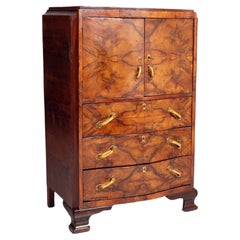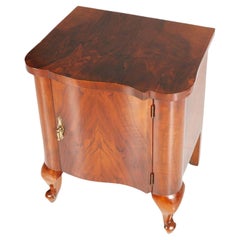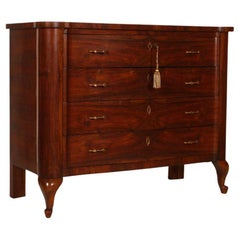Gaetano Borsani
| Average Sold Price |
| $1,276 |
| Styles |
| Materials |
| Related Creators |
Osvaldo Borsani Mid-Century Modern Italian Walnut and Maple Sideboard, 1950s
By Gaetano Borsani, Arredamenti Borsani
Located in Puglia, Puglia
This bar sideboard was produced by Arredamenti Borsani Varedo, in Italy in the 1950s. The sideboard is in walnut and maple, mirrors and glass. The particularity is the overlying glas...
Category
1950s Italian Mid-Century Modern Vintage Gaetano Borsani
Materials
Glass, Mirror, Maple, Walnut
H 52.76 in W 77.56 in D 22.45 in
Art Deco Trumeau Cabinet in Walnut Briar by Atelier di Varedo, Gaetano Borsani
By Atelier Borsani Varedo, Gaetano Borsani
Located in Vigonza, Padua
Art Deco Trumeau Cabinet in Walnut Briar by Atelier di Varedo, Gaetano Borsani, with three external drawers, spacious upper compartment that can be opened with two doors containing t...
Category
Early 20th Century Italian Art Deco Gaetano Borsani
Materials
Walnut
H 55.12 in W 35.44 in D 21.66 in
Libreria E22 Osvaldo Borsani per Tecno 1960's
By Tecno, Gaetano Borsani
Located in Milano, MI
Splendida Libreria E22 disegnata da Osvaldo Borsani per Tecno spa negli anni 60.
molteplici mobili contenitori bassi e modulo bar con ribalta.
E' Possibile rimuovere i pannelli poste...
Category
Mid-20th Century Italian Mid-Century Modern Gaetano Borsani
Materials
Aluminum, Steel
1930s Art Deco Commode in Burl Walnut by Osvaldo Borsani Per Atelier Di Varedo
By Osvaldo Borsani, Gaetano Borsani
Located in Vigonza, Padua
Majestic and elegant chest of drawers by Osvaldo Borsani produced in the Varedo Atelier of his father Gaetano Borsani , original in every part, with bakelite handles, 1930s Art Deco chest of drawers, commode , in burl walnut with mirror, polished to wax. Excellent condition.
Measures cm: D 53, W 120, H 100.
mirror cm: W 90 H 75.
About Osvaldo Borsani
Osvaldo Borsani (born 1911, Varedo, Italy–died 1985, Milano, Italy) was an Italian designer and architect, born into a family of furniture makers with along and well established artisanal tradition. His father, Gaetano Borsani, owned his own furniture shop, the Atelier di Varedo, where the 16-year-old Osvaldo received his first training. At that time, the designer of the atelier was the architect Gino Maggioni, who brought with him influences of the early 20th century Jugendstil movement from Vienna and who instilled in the young Borsani an appreciation for the arts and crafts and furniture making. Osvaldo Borsani first studied fine arts at Accademia di Belle Arti di Brera in Milan, graduating in 1931, and then pursued studies in architecture at Politecnico di Milano, where he graduated in 1936.
In 1933, two years before graduating as an architect, Borsani designed the Casa Minima project for the V Triennale di Milano (Milan Triennial), along with architects Cairoli and Varisco. This project earned him a silver medal for its Rationalist code and geometries, and he received positive reviews from the critic Edoardo Persico of Casabella magazine.
Villa Borsani And Other Prominent Architectural Work
In 1937, Osvaldo Borsani designed Villa Presenti in Forte dei Marmi, a sea town in Tuscany where the Italian aristocracy and industrial elite would build their houses, a project that displayed the same rationalistic rigor displayed in Casa Minima, but softened by the use of mediterranean finishes and materials.
Villa Borsani designed by Osvaldo Borsani. Varedo, Italy
Villa Borsani. Varedo, Italy
In 1943, Osvaldo designed and built his own house, the Villa Borsani, in Varedo, which, despite being conceptualized under strict Rationalist principles, incorporated objects and art of younger artists that communicate a freer approach to the human expression. The Villa Borsani project involved artists such as Adriano Spilimbergo, Fausto Melotti, Lucio Fontana (who made the ceramic fireplace and the ceramic Madonna), and Agenore Fabbri (who made the bronze statue in the staircase). To this day, Villa Borsani has been preserved with most of its original furniture and it remains with Osvaldo Borsani’s family along with the extensive archives of his work.
Osvaldo Borsani As a Successful Product and Furniture Designer
After Villa Borsani, Osvaldo continued to develop many projects for the Milanese bourgeoisie, frequently with many of the same artists whom he employed for his villa. A particularly strong relationship was the one that Osvaldo developed with artist Lucio Fontana, a close friend since the time of the Accademia de Belle Arti di Brera, and whom Borsani assigned to make a large metal balcony for the Tecno company in 1956.
Osvaldo Borsani’s design work, just as his larger architectural projects, which he also considered design work, very often incorporated elements created by other artists and designers such as: Roberto Crippa, Arnaldo and Giò Pomodoro, Agenore Fabbri, Fausto Melotti, Andrea Cascella...
Category
1920s Italian Art Deco Vintage Gaetano Borsani
Materials
Mirror, Walnut, Burl
H 39.38 in W 47.25 in D 20.87 in
Pair of buffets Gaetano Borsani Atelier Varedo Deco 1930s'
By Atelier Borsani Varedo, Gaetano Borsani
Located in Arezzo, IT
Pair of sideboards in briarwood, marble and Bakelite designed by Gaetano Borsani for Atelier di Varedo in the 1930s.
The sideboards are in good overall condition, considering that t...
Category
1930s Vintage Gaetano Borsani
Materials
Marble
Mid-Century Art Decò Venetian Baroque Night Stands by Gaetano E Osvaldo Borsani
By Osvaldo Borsani, Gaetano Borsani
Located in Vigonza, Padua
Elegant Venetian night stand from the 1930s produced by Gaetano Borsani and attributed to the young Osvaldo Borsani, with shaped top and rounded shaped, made of veneered walnut. Golden brass opening handle. Revised and wax polished.
The commode of this nightstands is published with code FP12a.
About Gaetano e Osvaldo Borsani.
Osvaldo Borsani (born 1911, Varedo, Italy–died 1985, Milano, Italy) was an Italian designer and architect, born into a family of furniture makers with along and well established artisanal tradition. His father, Gaetano Borsani, owned his own furniture shop, the Atelier di Varedo, where the 16-year-old Osvaldo received his first training. At that time, the designer of the atelier was the architect Gino Maggioni, who brought with him influences of the early 20th century Jugendstil movement from Vienna and who instilled in the young Borsani an appreciation for the arts and crafts and furniture making. Osvaldo Borsani first studied fine arts at Accademia di Belle Arti di Brera in Milan, graduating in 1931, and then pursued studies in architecture at Politecnico di Milano, where he graduated in 1936.
In 1933, two years before graduating as an architect, Borsani designed the Casa Minima project for the V Triennale di Milano (Milan Triennial), along with architects Cairoli and Varisco. This project earned him a silver medal for its Rationalist code and geometries, and he received positive reviews from the critic Edoardo Persico of Casabella magazine.
Villa Borsani And Other Prominent Architectural Work
In 1937, Osvaldo Borsani designed Villa Presenti in Forte dei Marmi, a sea town in Tuscany where the Italian aristocracy and industrial elite would build their houses, a project that displayed the same rationalistic rigor displayed in Casa Minima, but softened by the use of mediterranean finishes and materials.
Villa Borsani designed by Osvaldo Borsani. Varedo, Italy
Villa Borsani. Varedo, Italy
In 1943, Osvaldo designed and built his own house, the Villa Borsani, in Varedo, which, despite being conceptualized under strict Rationalist principles, incorporated objects and art of younger artists that communicate a freer approach to the human expression. The Villa Borsani project involved artists such as Adriano Spilimbergo, Fausto Melotti, Lucio Fontana (who made the ceramic fireplace and the ceramic Madonna), and Agenore Fabbri (who made the bronze statue in the staircase). To this day, Villa Borsani has been preserved with most of its original furniture and it remains with Osvaldo Borsani’s family along with the extensive archives of his work.
Osvaldo Borsani As a Successful Product and Furniture Designer
After Villa Borsani, Osvaldo continued to develop many projects for the Milanese bourgeoisie, frequently with many of the same artists whom he employed for his villa. A particularly strong relationship was the one that Osvaldo developed with artist Lucio Fontana, a close friend since the time of the Accademia de Belle Arti di Brera, and whom Borsani assigned to make a large metal balcony for the Tecno company in 1956.
Osvaldo Borsani’s design work, just as his larger architectural projects, which he also considered design work, very often incorporated elements created by other artists and designers such as: Roberto Crippa, Arnaldo and Giò Pomodoro, Agenore Fabbri, Fausto Melotti, Andrea Cascella...
Category
Mid-20th Century Italian Mid-Century Modern Gaetano Borsani
Materials
Walnut
H 23.63 in W 17.72 in D 13.78 in
Mid-Century Art Decò Venetian Baroque Commode by Gaetano e Osvaldo Borsani
By Osvaldo Borsani, Gaetano Borsani
Located in Vigonza, Padua
Elegant Venetian chest of drawers from the 1930s produced by Gaetano Borsani and attributed to the young Osvaldo Borsani, with shaped top and rounded shapes with 4 drawers, made of veneered walnut. Golden brass opening handles. Revised and wax polished.
His two bedside tables published with code FP12b
About Gaetano e Osvaldo Borsani
Osvaldo Borsani (born 1911, Varedo, Italy–died 1985, Milano, Italy) was an Italian designer and architect, born into a family of furniture makers with along and well established artisanal tradition. His father, Gaetano Borsani, owned his own furniture shop, the Atelier di Varedo, where the 16-year-old Osvaldo received his first training. At that time, the designer of the atelier was the architect Gino Maggioni, who brought with him influences of the early 20th century Jugendstil movement from Vienna and who instilled in the young Borsani an appreciation for the arts and crafts and furniture making. Osvaldo Borsani first studied fine arts at Accademia di Belle Arti di Brera in Milan, graduating in 1931, and then pursued studies in architecture at Politecnico di Milano, where he graduated in 1936.
In 1933, two years before graduating as an architect, Borsani designed the Casa Minima project for the V Triennale di Milano (Milan Triennial), along with architects Cairoli and Varisco. This project earned him a silver medal for its Rationalist code and geometries, and he received positive reviews from the critic Edoardo Persico of Casabella magazine.
Villa Borsani And Other Prominent Architectural Work
In 1937, Osvaldo Borsani designed Villa Presenti in Forte dei Marmi, a sea town in Tuscany where the Italian aristocracy and industrial elite would build their houses, a project that displayed the same rationalistic rigor displayed in Casa Minima, but softened by the use of mediterranean finishes and materials.
Villa Borsani designed by Osvaldo Borsani. Varedo, Italy
Villa Borsani. Varedo, Italy
In 1943, Osvaldo designed and built his own house, the Villa Borsani, in Varedo, which, despite being conceptualized under strict Rationalist principles, incorporated objects and art of younger artists that communicate a freer approach to the human expression. The Villa Borsani project involved artists such as Adriano Spilimbergo, Fausto Melotti, Lucio Fontana (who made the ceramic fireplace and the ceramic Madonna), and Agenore Fabbri (who made the bronze statue in the staircase). To this day, Villa Borsani has been preserved with most of its original furniture and it remains with Osvaldo Borsani’s family along with the extensive archives of his work.
Osvaldo Borsani As a Successful Product and Furniture Designer
After Villa Borsani, Osvaldo continued to develop many projects for the Milanese bourgeoisie, frequently with many of the same artists whom he employed for his villa. A particularly strong relationship was the one that Osvaldo developed with artist Lucio Fontana, a close friend since the time of the Accademia de Belle Arti di Brera, and whom Borsani assigned to make a large metal balcony for the Tecno company in 1956.
Osvaldo Borsani’s design work, just as his larger architectural projects, which he also considered design work, very often incorporated elements created by other artists and designers such as: Roberto Crippa, Arnaldo and Giò Pomodoro, Agenore Fabbri, Fausto Melotti, Andrea Cascella...
Category
1930s Italian Baroque Revival Vintage Gaetano Borsani
Materials
Walnut
H 38.19 in W 50.01 in D 21.66 in
Gaetano Borsani Italian Art Deco Rosewood Sideboard or Bar Cabinet, 1930s
By Atelier Borsani Varedo, Gaetano Borsani
Located in South Bend, IN
An exceptional Italian Art Deco sideboard, credenza, or bar cabinet
By Gaetano Borsani for Atelier Borsani Varedo,
Italy, 1930s
Indian rosewood, with ebonized top and base, ...
Category
1930s Italian Art Deco Vintage Gaetano Borsani
Materials
Chrome
H 35.88 in W 69.88 in D 17.5 in
Browse all Furniture from Gaetano Borsani
Shop NowGaetano Borsani Sellers
Creators Similar to Gaetano Borsani
Gaetano Borsani furniture for sale on 1stDibs.
Gaetano Borsani furniture are available for sale on 1stDibs. These distinctive items are frequently made of wood and are designed with extraordinary care. There are many options to choose from in our collection of Gaetano Borsani furniture, although brown editions of this piece are particularly popular. Many of the original furniture by Gaetano Borsani were created in the Art Deco style in italy during the 20th century. If you’re looking for additional options, many customers also consider furniture by Meroni & Fossati, Consorzio Esposizione Mobili Cantù, and Paolo Lietti & Figli. Prices for Gaetano Borsani furniture can differ depending upon size, time period and other attributes — on 1stDibs, these items begin at $2,441 and can go as high as $14,424, while a piece like these, on average, fetch $8,966.







